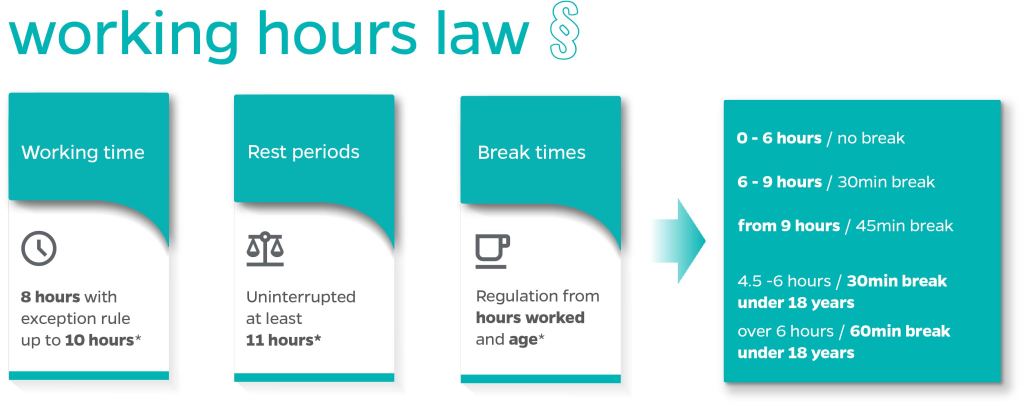Shift Scheduling 24/7 – Shift Scheduling Around the Clock

Shift work is a central part of many industries and plays an essential role in our globalized and 24/7 world. From manufacturing to healthcare to public sector such as the police and fire department, modern life often requires people to work at unusual hours. But what challenges and opportunities does shift work bring along? And how can workforce management support?
Contents
↓ What does shift work mean?
↓ What are the challenges of shift work?
↓ What chances does shift work offer?
↓ What regulations apply to time recording in shift work?
↓ How can workforce management be used to optimize shift schedules for shift workers?
What does shift work mean?
Shift work refers to a working time model in which working hours are divided into different time periods, known as shifts. This allows facilities or services to operate continuously throughout the day and night. Shift work is particularly necessary in industries where continuous availability is required, such as healthcare, production and logistics, as well as in the public sector.
Shifts can vary and typically include:
- Early shift: this starts in the early hours of the morning and ends in the early afternoon.
- Late shift: This starts in the afternoon and ends in the late evening.
- Night shift: This starts in the late evening and ends in the early morning.
Some workplaces also use shift systems with split or overlapping shifts to meet specific operational requirements. The change between shifts often follows a set rotation schedule to ensure an even distribution of stress and recovery periods.
There are different models of shift work:
- Two-shift system: With only two shifts, e.g. early and late shifts.
- Two-shift system: With only two shifts, e.g. early and late shifts.
- Three-shift system: With early, late and night shifts that rotate in a regular rhythm.
- Four- or five-shift system: This model is used when a company runs around the clock every day of the week and must also comply with special working time regulations due to collective agreements. It ensures that continuous production is guaranteed without contravention of labor law regulations.
- 4-shift system:
- Rotating shifts with a rest day after a certain number of working days
- Always three active shifts and one rest shift
- Shorter recovery phases compared to the 5-shift system
- 5-shift system:
- Rotating shifts with two rest days after a certain number of working days
- Always three active shifts and two resting shifts
- Longer recovery periods, which can lead to a better work-life balance
- 4-shift system:
- Continuous shift operation: This model describes an operation that runs continuously, i.e. 24 hours a day, seven days a week. To make this possible, at least three shifts, each of it with eight hours, are required. This division ensures that the legal requirements regarding rest periods and maximum working hours are complied with.
- Semi-continuous shift operation with night work: Here, work is carried out around the clock on five days a week, usually from Monday to Friday, which also requires three-shift operation. In contrast to the full-contract model, however, weekends can be kept free.
- Semi-continuous shift model without night work: This model dispenses with night work and therefore does not work 24 hours a day, but can be active seven days a week.
- Discontinuous shift system: Discontinuous shift systems are alternating early and late shifts without night shifts. Normally, working hours are distributed from Monday to Friday. However, it can also extend across a 5-day week to include Saturday.
What are the challenges of shift work?
Shift work poses a few challenges that can affect different areas of life. Health problems such as sleep disorders and an increased risk of chronic illnesses are at the top of the list. The irregular working hours disrupt the natural sleep-wake rhythm, which can lead to sleeplessness and lack of sleep. This in turn increases the risk of cardiovascular disease, gastrointestinal problems, diabetes and obesity. Mental health can also suffer, as shift work can promote stress, anxiety and depression.
Social and family challenges are also present as shift workers often lack the time for social interaction and family activities. This can lead to stress and conflict within the family. Added to this is the limited social support in the workplace.
Performance and safety can also be affected, as tiredness and lack of sleep affect concentration and reaction time, which can lead to errors and accidents. Working conditions such as an irregular schedule and lack of support further intensify these problems.
Diet and lifestyle can also suffer from shift work, as irregular working hours and lack of meal breaks can lead to unhealthy eating habits and lack of exercise.
To overcome these challenges, measures are required at an individual and organized level. These include healthy lifestyle habits, stress management, ergonomic working hours and support from the employer.
Employers can exert influence by offering training and workshops on stress management and healthy lifestyles, introducing flexible working time models and home office options, providing ergonomic workstations, organizing regular health checks and creating a supportive working environment that promotes open communication and social support.
In addition, using a workforce management solution can help to better plan and optimize the workforce by creating transparency, avoiding overwork and ensuring that the right people are in the right place at the right time.

What chances does shift work offer?
Shift work also offers a variety of opportunities and possibilities for employees. One of the most advantages is the flexibility of working hours. By working in shifts, employees can better adapt their working hours to their personal needs and commitments. This can be beneficial for parents, students or people with other commitments outside of work.
In addition, shift work offers the opportunity to reach a better work-life balance. By allowing employees to divide their working hours into shifts, they often have more flexibility to care for their family members or pursue personal interests. This can help to reduce stress and improve work-life balance.
Another benefit of shift work are the often higher wages compared to regular working hours. Many companies offer shift allowances to reward the special demands and flexibility that shift work entails. This can help to increase employees’ income and provide additional financial motivation to take on shift work.
Shift work can also promote career development, as employees often have the opportunity to work in different shifts and departments. This allows them to get varied experience and learn new skills, which can improve their career prospects.
What regulations apply to time recording in shift work?
Time recording in shift work is governed by various legal and company regulations. Here are the most important aspects:
Working Hours Act (ArbZG): The German Working Hours Act regulates maximum working hours, rest periods and breaks. The following points are relevant for shift work:
- Maximum daily working hours: As a rule, working hours may not be longer than eight hours per day. It can be extended to up to ten hours if an average of eight hours is not exceeded within six calendar months or 24 weeks.
- Rest periods: At the end of the daily working time, an uninterrupted rest period of at least eleven hours must be observed. There are exceptions, e.g. in the healthcare sector or when caring for people.
- Break regulations: A minimum of 30 minutes break is required for working hours of more than six to nine hours, and at least 45 minutes for working hours of more than nine hours.

*Working time laws vary from country to country, which can make compliance and management of working hours a complex task. However, with a flexible workforce management solution such as plano, it is possible to map these country-specific regulations individually. Whether maximum working hours, break regulations or overtime allowances – plano enables companies to meet the legal requirements of each country precisely and efficiently. This allows companies worldwide to optimize their work processes and ensure legal compliance at the same time.
Company agreements and wage agreements: In many industries, there are specific wage agreements and company agreements that can regulate working hours and time recording in more detail. These agreements may include additional provisions on shift premiums, rest periods and other aspects relevant to working hours.
Obligations to document: According to Section 16 ArbZG, employers are obliged to record employees’ working hours which exceed the contracted working hours. This means that precise documentation of working hours is required for shift work. This can be done by manual recording, electronic time recording systems or other suitable methods.
ECJ ruling on time recording: According to a ruling by the European Court of Justice (ECJ) in May 2019, employers are obliged to set up a system to record daily working hours. This judgment emphasizes the need to accurately record working hours in order to ensure compliance with statutory working time regulations.
Occupational health and safety: Occupational health and safety is also relevant in shift work, as irregular working hours and night shifts can be harmful to health. Employers must therefore take measures to ensure the health and safety of employees, e.g. through ergonomic shift schedules and recovery periods.
Overall, time recording in shift work must ensure that legal and contractual provisions are complied with and that working hours are documented in a transparent and understandable manner.
Source: https://www.gesetze-im-internet.de/arbzg/BJNR117100994.html /
How can workforce management be used to optimize shift schedules for shift workers?
With a modern workforce management solution, it is possible to implement clear shift scheduling that allows the shifts in the company to be planned efficiently as required.
Good shift scheduling allows a shift plan to be created quickly, efficiently and simply. Employees are clearly visible at a glance and planners can react flexibly to any necessary changes. The shift schedule is adapted to the specifics of each industry and takes all relevant factors into account. It is not just a matter of mapping the different shifts (e.g. rolling shifts or alternating shifts), statutory working time regulations as well as collective bargaining and company regulations must also be considered. In addition, there are industry-specific demand drivers that can be used to forecast staffing requirements.
Demand analysis and forecasting
Effective workforce management begins with a precise needs analysis. By analyzing historical data, seasonal fluctuations and specific company needs, staffing requirements can be forecast more exactly. Modern WFM systems use advanced algorithms to recognize patterns and accurately predict future requirements. This makes it possible to proactively design shift schedules and avoid over- or understaffing.
Automated shift schedule creation
Traditionally, schedules have been created manually, which is time-consuming and sensitive to errors. By using workforce management software, this process can be automated. The software considers a variety of factors such as legal requirements, employment contract regulations, employee preferences and qualifications. This leads to more efficient and fairer shift schedules that meet both operational requirements and employee’s needs.
Mapping of individual shift patterns
A suitable workforce management system should also take into account the individual shift patterns of employees. It is often the case that employees always work the same shifts in a certain rhythm, e.g. one week of early shift followed by one week of late shift. A modern digital WFM solution uses shift patterns, which means that the planner does not have to plan each shift individually and the planning effort is significantly reduced.
Flexibility and adjustments in real time
Another advantage of WFM is the ability to flexibly adjust shift schedules in real time. Unforeseen events such as sickness absences, sudden order peaks or technical faults can be taken into account immediately. This is made possible by a mobile employee portal that enables rapid communication and adjustment of shift schedules. Employees can enter availabilities or request shift changes at short notice, which increases the company’s flexibility and responsiveness.
Consideration of employee preferences
A happy team is more productive and loyal. WFM systems can incorporate employee preferences regarding shift times, days off and vacation scheduling. By integrating these preferences into the shift scheduling process, employee satisfaction is increased. At the same time, conflicts and absenteeism can be reduced, as employees are more willing to fulfill their shifts conscientiously if their personal needs are taken into account.
Compliance and fairness
Compliance with labor law regulations is another critical aspect of shift scheduling. A WFM solution ensures that all legal regulations such as maximum working hours, rest periods and break regulations are observed. In addition, they enable shifts to be distributed fairly to avoid overworking individual employees. This minimizes the risk of legal problems and promotes a fair working environment.
Cost control and increased efficiency
By optimizing schedules, staff costs can also be reduced. Precise planning reduces the need for overtime and temporary work. In addition, productivity and efficiency can be increased by optimizing shift staffing. This leads to better use of resources and contributes to the company’s profitability.
Conclusion:
Workforce management offers numerous opportunities to optimize shift worker schedules. By combining demand analysis, automated planning, flexibility, consideration of employee preferences, compliance with legal requirements and cost control, companies can increase their operational efficiency and at the same time increase employee satisfaction. The use of modern WFM systems is therefore a decisive step towards future-oriented and effective shift scheduling.
With our plano WFM solution, shift schedules can be created automatically and shifts are distributed fairly. Thanks to precise forecasts, you always have an overview of staff demand and current coverage and can adjust your staff planning at any time. This reduces overstaffing and understaffing and ensures higher productivity.
With Dr. Scherf Schütt & Zander GmbH (SSZ Beratung) and XIMES GmbH, we have two strong partners at our side who can advise you on the implementation of suitable concepts for modern working time models. Together, we focus on fair and transparent workforce management with flexible shift scheduling and employee participation.
You can find another exciting blog post on the topic of the 4-day week here:
https://plano-wfm.com/en/4-day-workweek-scheduling-workforcemanagement/
Would you like to find out more?
Further information about our workforce management software and the
areas of application here:
Archive
Employee Retention in Retail
We’re Here for You

